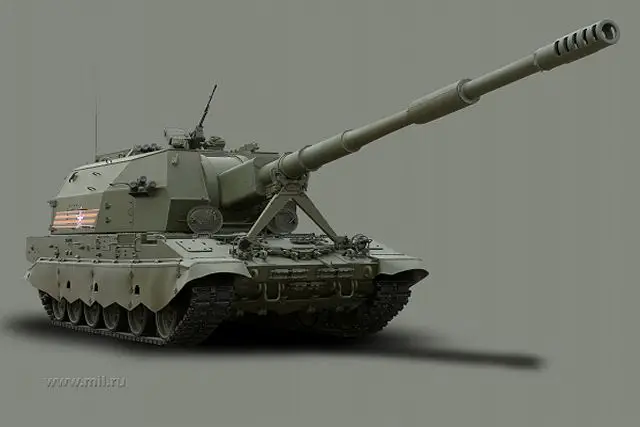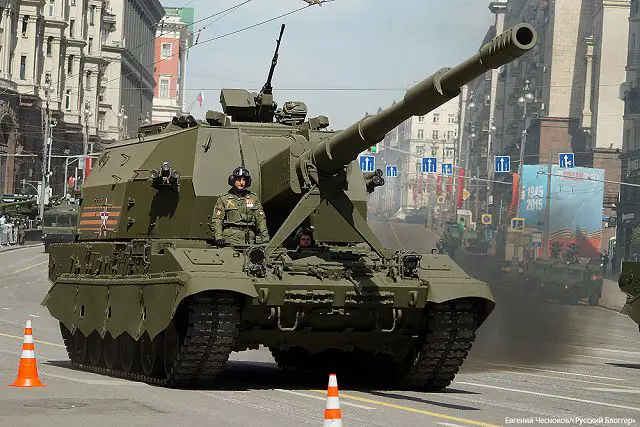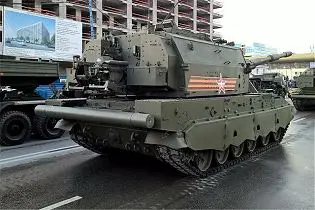The 2S35 Koalitsiya-SV (Russian: 2С35 Коалиция-СВ) is a new generation of Russian-made self-propelled tracked howitzer based on the 2S19 chassis fitted with a new turret. It is a successor to the 2S19 Msta-S. It is also intended to replace ageing Russian 152-mm artillery systems.
The 2S35 was originally designed as a variant of the 2S19 Msta, consisting of a 2S19 chassis with modified turret, fitted with an over-and-under dual autoloaded 152mm howitzer.
The first demonstrator was completed in 2006.
This unique self-propelled howitzer had two 152-mm guns. It used a number of components from the previous 2S19 Msta-S. The twin-barrel Koalitsiya-SV demonstrator had a higher rate of fire than current artillery systems. It could fire at around 16 rounds per minute. The twin-barrel demonstrator had a higher rate of fire than current artillery systems. It could fire at a rate of around 16 rounds per minute. This demonstrator had a fully-automatic ammunition loading and handling systems. Two barrels have a number of other advantages comparing with usual self-propelled howitzers. Such artillery system is more reliable as both guns have associated autoloaders and if one of them fails, another keeps on firing. This self-propelled howitzer used both barrels in quick succession, so the guns did not overheat and had twice longer service life. This demonstrator of the Koalitsiya-SV could load both barrels at any inclination angles. This self-propelled howitzer was capable of multiple round simultaneous impact firing. It could also launch two precision-guided rounds, that will hit two different targets simultaneously. The demonstrator had a crew of 5, however it was planned that production Koalitsiya-SV would have a high level of automation. Demonstrator of the Koalitsiya-SV used a modified Msta-S chassis. However this project was cancelled. For some reason twin-barrel design was abandoned.
In 2013 a new prototype of the Koalitsiya-SV was completed. It had a different design and only one gun. Production of the 2S35 Koalitsiya-SV commenced in 2014. A first batch of 12 artillery systems was delivered to the Russian Army in 2015. It was first publicly revealed during the same year.
Design
The 2S35 is expected to have a very high level of automation that will dramatically reduce the crew number, to perhaps just two or three people located in an armored capsule below the two front hull hatches.The hull and turret is of all-welded steel armour construction which provides protection from small arms fire, shell splinters and mines.
Armament
The 2S35 Koalitsiya-SV tracked self-propelled howitzer is armed with the new 2A88 cannon 152mm which is under development. During travelling, the cannon is held in position by a travelling lock mounted on the glacis plate. To increase its self-protection, a remote weapon station armed with a 12.7mm Kord machine is mounted on the top of the turret. Three smoke grenade dischargers are mounted either side at the front of the turret.
The turret is also equipped with an automatic loading system. The S2S35 is able to fire a new generation of 9K25, the 152 mm Krasnopol laser-guided projectile. When the Krasnopol is in flight, four fixed fins unfold to the rear with four movable control surfaces unfolding to the front. It uses inertial guidance for the middle part of the trajectory with semi-active laser homing being used for the terminal phase when the target is illuminated by the tripod-mounted laser designator. The Koalitsiya-SV is equipped with remote firing control system.
Accessories
Standard equipment of the 2S35 Koalitsiya-SV includes NBC protection system, night vision, computerized fire control and screens for each members of the crew to control firing operations. A rectangular box is mounted on each side of the main armament, which can be monitors able to provide combat mission information. Each members of the crew have screens which displays data for sight systems and to control all firing procedures.
Mobility
The 2S35 Koalitsiya-SV could be based on the chassis of the T-90 MBT. The suspension is of the torsion bar type with either side having six roadwheels, idler at the front, drive sprocket at the rear and five track-return rollers, with the upper part of the track being covered by a skirt


